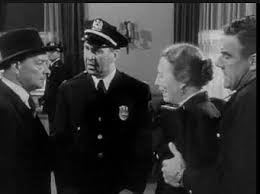Henry Hathaway’s
Fourteen
Hours, a black-and-white bouquet of surprises from the tabloid
era, is a compelling ensemble piece filled with intriguing details and future
stars.
The narrative centers on whether Robert Cosic/k (Richard
Basehart), a young man bedeviled by conflicted feelings about his divorced
parents and his former fiancée, can be talked inside from a 15th-floor
Manhattan hotel ledge from which he threatens to jump. Italian filmmaker
Federico Fellini reportedly cast Basehart in
La Strada
(1954) because he was impressed by his work in
Fourteen Hours. Fellini also cast Basehart in
Il Bidone
(1955).
The bold visual sensibility compares to that of New York
tabloid photographer Weegee [Arthur Fellig]. And just as Cosic is in every
sense near and yet so far away, each actor’s body language emphasizes the
distance to the ground no less than the camera. The viewer never loses a
visceral sense of how far down the street is from Cosic and his would-be
rescuers nor of the relief that people feel to get both feet back on solid
ground.
There is no movie music to give emotional cues. The only
music comes with the opening credits and at the close. The film’s background
sounds are from the streets of New York. Human foibles with unintended
consequences give authenticity to Cosic’s 14 hours on the ledge.
The main dialogue is between Cosic and Patrolman Charles
Dunnigan (Paul Douglas) who spotted Cosic on the ledge while walking his
morning traffic beat. Dunnigan is solidly-grounded, an all-American,
liver-and-bacon, working-class mensch from Bayside, Queens. His calm presence
makes him the only person Cosic trusts. Their dialogue forms the core of an
ensemble of capable actors, no less the City of New York watching the spectacle
from the streets below and surrounding office buildings.
Grace Kelly appears in her first film as Louise Ann Fuller,
watching the man on the ledge from the windows of a law office where she is
meeting with her husband (James Warren) and their lawyers to finalize the terms
of their divorce. At street level, a young Ozzie Davis is one of five wry
cabdrivers with a pool over when the man will jump. John Cassavetes and Brian
Keith have uncredited background roles: Keith appears at a television monitor;
Cassavetes may be operating a large television camera.
The New York Police Department works its mission in spite of
city government and its own bureaucracy. Deputy Police Chief Moksar (Howard da
Silva), in charge of emergency services, directs the rescue operation from
Cosic’s hotel room through a pecking-order chain-of-command, receiving his
orders from above by telephone. His rolling eyes leaven the dramatic tension:
he is used to being in charge, but loyal aides need direction and the best
ideas often come from flatfeet.

Called in to help talk their son from the ledge, Cosic’s
long-divorced parents, Christine Hill Cosic (Agnes Moorehead) and Paul E. Cosic
(Robert Keith, Brian Keith’s actual father), play out the toxic family dynamic in
the hotel room within their son’s hearing and before police officials and psychiatrists.
Police also bring in Cosic’s former fiancée Virginia Foster (Barbara Bel
Geddes) to try to assist their effort. At the same time, new love buds when boy
meets girl in the crowd on the street: Ruth (Debra Paget) and Danny Klempner
(Jeffrey Hunter).
Thus we have a divorced couple with a son confused about his
parents and his own matrimonial future, possibly his sexuality; a couple whose
lawyers are negotiating a divorce; a grounded, happily-married, middle-aged
Everyman looking forward to his wife Helen’s (Ann Morrison) cooking; and a
young couple who meet on the street below.
The story was inspired by reporting by Joel Sayre titled
“This Is New York: The Man on the Ledge,” published in
The New Yorker on 16 April 1949. Sayre wrote about the suicide of
26-year-old
John W. Warde. On 26
July 1938, Warde jumped 17 floors to his death from a ledge of Hotel Gotham, a 23-story
Beaux Arts hotel at
700 Fifth Avenue
in midtown Manhattan
. This hotel is now
The Peninsula New York.
The film’s Hotel Rodney was The Guaranty Trust Co. bank
building on Broadway in lower Manhattan, redressed as a hotel. From the ledge,
viewers can see the Woolworth Building to the north and Trinity Church closer
and to the south. The bank, demolished in 1967, was replaced by the 52-story
Midland Marine Building at 140 Broadway, notable for Isamu Noguchi’s “Red Cube”
in its plaza.
The young man’s name is spelled “Cosick” on a police
bulletin. But Moksar spells it out “C-o-s-i-c” and adds, “Whatever kind of name
that is.” It likely is an Americanized version of the Croatian or Serbian Ćosić [Tsosits].
 |
| “So what is it? Advertising?”—“Could be.”—“It
could.” |
Fourteen Hours
1951 U.S.; Twentieth Century-Fox (92 minutes). Directed by Henry Hathaway;
screenplay by John Paxton, based on a story by Joel Sayre; cinematography by
Joseph MacDonald; editing by Dorothy Spencer; produced by Sol C. Siegel.









